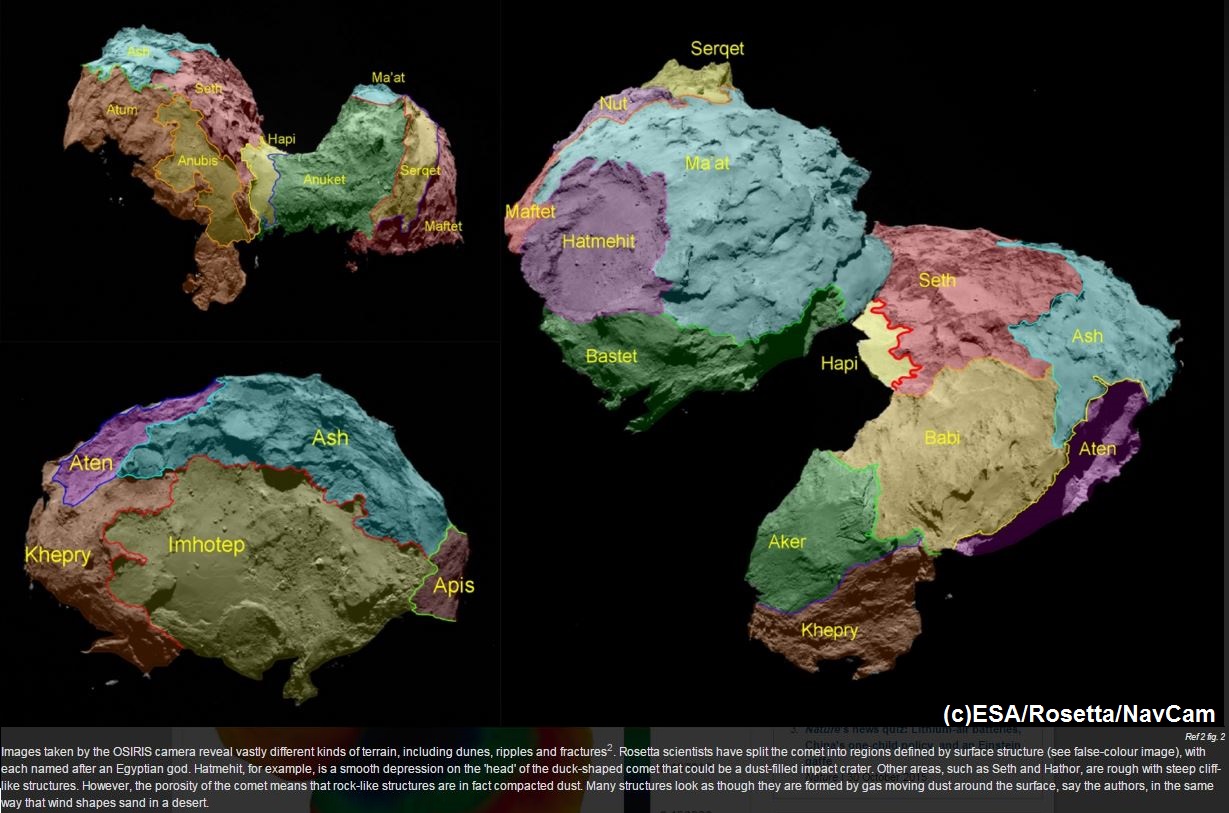by FPDieulois :: 2025-10-26
Rosetta sniffs oxygen around comet 67P (Nature Post)
The presence of the gas could have implications for theories of the early Solar System.
Scientists have detected molecules of oxygen in the hazy halo of comet 67P/Churyumov_Gerasimenko
an unexpected discovery that may challenge theories about the formation of the Solar System.
The detection, made by an instrument on board the European Space Agency_s Rosetta spacecraft,
was reported today (28 October 2015) in Nature
Science pours in from Rosetta comet mission
ROSETTA SNIFFS OXYGENE ON CHURI

Rosetta sniffs oxygen around comet 67P
Mysterious origins
It was not immediately clear where the oxygen came from.
The team discovered that water and oxygen were often found together
an indication that similar processes released both molecules.

10 years ago, in the chilly expanse of space some 480 million kilometers from Earth, a European spacecraft named Rosetta achieved what was once the stuff of science fiction:
it orbited a comet, deployed a lander, and began unraveling the secrets of our solar system's ancient past.
Launched in 2004, Rosetta's decade-long journey culminated in August 2014 when it rendezvoused with Comet 67P/Churyumov-Gerasimenko,
a peanut-shaped wanderer hurtling through the void every 6.5 years. But it was in October 2015, exactly a decade from now,
that one of the mission's most astonishing revelations emerged: the detection of molecular oxygen (O2) in the comet's coma—the hazy envelope of gas and dust surrounding its icy nucleus.
This "most surprising discovery to date," as mission scientists called it, not only rewrote our understanding of cometary chemistry
but also offered a tantalizing glimpse into the solar system's turbulent infancy.
Comet 67P, discovered in 1969 by Soviet astronomers Klim Churyumov and Svetlana Gerasimenko,
is no ordinary space rock. Roughly four kilometers across, it's a pristine relic from 4.5 billion years ago, when the solar system coalesced from a swirling disk of gas and dust.
Comets like 67P are often dubbed "time capsules" because their materials have remained largely unaltered since the planets formed.
Rosetta, equipped with 11 state-of-the-art instruments, shadowed the comet for two years, from perihelion (its closest approach to the Sun in August 2015) through its outbound journey.
The spacecraft's crowning achievement came on November 12, 2014, when the Philae lander touched down—bouncing twice before settling in a shadowed crevice.
Though Philae's batteries died after just 60 hours, Rosetta itself persisted, transmitting over 100,000 images and petabytes of data until its controlled crash-landing on the comet's surface in September 2016.
The oxygen breakthrough stemmed from Rosetta's ROSINA instrument, the Rosetta Orbiter Spectrometer for Ion and Neutral Analysis.
Led by Kathrin Altwegg of the University of Bern, ROSINA sniffed the comet's outgassing coma like a cosmic bloodhound.
Between September 2014 and March 2015, as 67P warmed under the Sun's gaze, the spectrometer detected O2 at levels making it the fourth most abundant molecule—trailing only water vapor (H2O), carbon monoxide (CO), and carbon dioxide (CO2).
This wasn't trace contamination or fleeting ions; it was stable, primordial O2, released steadily from the nucleus itself, comprising up to 4% of the coma at peak activity.
"We had never thought that oxygen could 'survive' for billions of years without combining with other substances," Altwegg remarked, capturing the sheer disbelief rippling through the team.
What made this find so jarring? Prior detections of oxygen in space—on icy moons like Europa or in Saturn's rings—were chalked up to photolysis (UV light splitting water) or radiolysis (high-energy particles fracturing molecules).
But 67P's oxygen didn't fit that mold. Its release correlated tightly with water vapor, suggesting both were primordial, trapped together in the comet's ice during formation.
Models by Cornell's Jonathan Lunine later showed how O2 could have been locked into the nucleus through "dual storage": frozen in clathrate hydrates or adsorbed onto dust grains in the cold molecular cloud that birthed the solar system.
As the comet sublimated—ice turning straight to gas under solar heat—this ancient O2 escaped unchanged, a survivor from an era before planets coalesced.
This revelation upended solar system formation theories. The prevailing nebular hypothesis posits a hot, turbulent disk where reactive gases like O2 should have bonded with hydrogen or metals early on, forming oxides or water.
Yet here was free O2, implying 67P formed in a colder, gentler environment—perhaps in the outer disk's frigid shadows, where temperatures plummeted below 30 Kelvin.
It challenges the "Grand Tack" model, where Jupiter's migration stirred the disk violently, and bolsters ideas of a more quiescent outer solar system.
Moreover, it ties into life's origins: while 67P's water isotope ratios (deuterium-to-hydrogen) differ from Earth's—ruling out comets as our oceans' sole source—
the presence of O2 alongside organics like glycine (a protein building block) and phosphorus hints at comets as chemical crucibles, delivering prebiotic ingredients during the Late Heavy Bombardment 4 billion years ago.
A decade on, Rosetta's oxygen legacy endures. Follow-up studies, including a 2019 Nature Astronomy paper, refined the release mechanisms, showing O2's even distribution in the nucleus.
The mission's trove has fueled hundreds of papers, reshaping comet science and inspiring successors like NASA's Europa Clipper or ESA's Comet Interceptor.
As we mark this milestone in 2025, Rosetta reminds us that the cosmos still harbors surprises—frozen breaths from the dawn of time, whispering secrets of our shared stellar heritage.
What other ancient gases lurk in the Kuiper Belt, waiting for the next probe? The universe, it seems, is still exhaling.

< B > My Personal Blog < B > List of all my Blog posts < B >
(c)FPe COPYRIGHT @FPDIEULOIS 2025